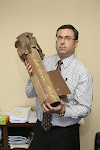The group of gray-haired men in sneakers, sunglasses and baseball hats did not stand out among the throngs of tourists and Israeli-flag-waving teenagers in Jerusalem’s Old City on Sunday.
Of the many thousands of people who filled the walled city for the celebration of Jerusalem’s reunification in 1967, only the men themselves knew that everyone else was there because of them.
Forty-five years ago, on the third day of the Six Day War, the paratroopers of Company A, 70th Battalion — tired and frightened young men in camouflage — were the first Israeli soldiers in the Old City, breaking through the Lions Gate under fire, seizing the Temple Mount and securing the Western Wall, an event now remembered as perhaps the pivotal moment of Israel’s history.
On Sunday, as on that Wednesday long ago, Yoram Zamosh was in charge. Zamosh, a lanky 69-year-old, was wearing a button-down shirt with stripes. The soldiers he commanded were now retirees, some with their children and grandchildren in tow. In 1967 Zamosh carried an Uzi. In 2012, he carried a plastic cup of orange juice.
The plan was to retrace the route of the company’s advance that day 45 years ago – from Lions Gate westward through the Old City to Jaffa Gate. But this slower and less heroic version of Company A decided to do it backwards, starting from Jaffa Gate, because it is much easier to find parking there.
Perhaps 30 of the company’s veterans crowded around Zamosh outside the Tower of David, where they arrived late in the day on June 7, 1967, after capturing the Western Wall. This was the final stage of the Jerusalem fighting.
“We came out of the alley,” Zamosh remembered, “and saw the Tower. There were Legionnaires, and a God-awful ruckus.”
Two of the company’s men were buried under rubble when a booby-trapped door blew up. The soldiers fired a bazooka at a guard post. One Legionnaire was killed. A second came out with his hands up.
Other veterans, giddy at the reunion, began shouting out corrections and additions to the story. The memories started coming out in a jumbled, confused chorus:
A hand grenade lobbed at the troops from a window in an Old City alleyway. “Yossi, you almost wet your pants, don’t play the hero.” The hand grenade? That wasn’t in the Old City, but in the Sheikh Jarrah neighborhood the day before. A soldier opening a Jordanian military refrigerator and finding Coca Cola, a rarity in Israel in those years. An Arab woman and her child killed by a rocket propelled grenade. Another soldier beating a drum left behind by a Jordanian marching band atop the Old City wall to show the people in the neighborhoods opposite the wall that there were Israelis inside and it was safe to come out.
From the Tower of David, the veterans of Company A made their way into the Old City in the direction of the Western Wall. A group of ecstatic yeshiva students in knitted kipot came past singing a song — “The redeemer has come to Zion” — at the top of their lungs, their messianic fervor directly linked to Company A’s actions that day in 1967. Avraham Shechter, 65, Zamosh’s dispatch runner, remembered a mortar shell that landed amid the men, broke apart and didn’t explode. It was an Israeli shell. He was spared that time, but would be badly wounded in a MiG attack when Company A was sent back in action along the Suez Canal in 1973.
On the morning of June 7, 1967, the hills around the Old City were rocked by Israeli artillery bombardments and napalm strikes.
“The ancient city of Jerusalem, which for generations we have dreamt and striven for – we will be the first to enter it,” the brigade commander, Motta Gur, told his troops over the radio as they prepared for the breakthrough. “The Jewish nation is awaiting our victory. Israel awaits this historic hour. Be proud. Good luck.”
At 9:45 a.m., Sherman tank shells ripped apart the 650-year-old Lions Gate. Zamosh’s half-track tore inside the walls.
The soldiers burst onto the Temple Mount, then tried to find their way to the Western Wall. An Arab man in a robe unlocked a low green door that led to a stairway leading down to a narrow alleyway adjacent to the Herodian stones.
Some of the men use lofty language to describe that moment.
“I’m not a religious man, but I felt I was borne on the wings of the Holy Spirit,” said Rafi Malka, the company’s number two officer.
“When we ran,” Zamosh said, “we felt the entire Jewish people pushing us from behind.”
When some of the others speak, though, it is still possible to see the soldiers they were 45 years ago.
“When we came down the stairs and reached the wall, we didn’t say anything. We didn’t know how to speak about feelings, and it was too big for us,” said Yossi Ofner, 65.
From afar, he remembered hearing Rabbi Shlomo Goren blowing his shofar as he approached – the first ecstatic sounds of the outburst of religious sentiment that would permanently change Israel. But in those first minutes no one cried and no one said a word.
“We were just kids,” he said.

